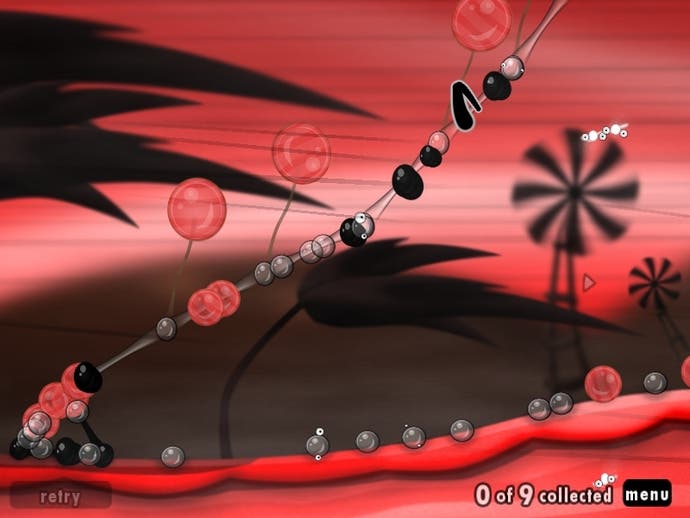World of Goo
Squishing well.
Little round blobs that form slightly elastic bonds when they're held up to one another. There's your core puzzle mechanic. From these beginnings, you can build a tower, or a bridge, or the means to escape from the belly of a giant creature and float, hearts filled with hope, on helium-filled eyeballs into outer space.
You simply cannot pin World of Goo down onto the wooden board and start methodically dissecting it with clear and concise scientific rationale. It has this horrible habit of coming back to life, jumping up and giving you a giant hug, then spinning on the spot until it gets dizzy and falling down giggling.
Eurogamer has of course previously (and magnificently) reviewed World of Goo when it was released on PC last year. Now it has reached WiiWare, and for good reason should be looked at all over again.
Goo begins by asking you to achieve small goals. The first level is about connecting the most basic Goo balls together to form a small tower, allowing the remaining blobs to run up the bonds of the structure and reach each level's goal, the exit pipe. "Weeeee!" they cry as they make their way inside it. The next level asks you to apply the same technique, but this time horizontally, using the Goo to create a short bridge. There's a minimum number of balls you need to save per level, but you're strongly encouraged to recover as many as you can beyond this target.

It would have been perfectly reasonable for these approaches to be applied in increasingly imaginative and complex ways as you progressed through the game, resulting in something fantastic. What you're not expecting is to soon be working out how to suspend a chain of single-bonding droplet Goos via floating red balloons so they don't allow the heavy wind to buffer them into the spinning blades of a windmill.
Or stacking blinking, sentient stone blocks into precarious towers to provide support for a thin bridge. Or firing pull-back-and-release balls into suspended chains. Or arranging flammable Goos into elaborate fuses to explode robots. Or rolling giant Goo balls over suspension bridges into crushing machines.
In fact, before Chapter One (of four, plus an epilogue) ends, you'll encounter the first dramatically different approach. The Tumbler has the green Goos - those capable of forming three detachable bonds - in a revolving, octagonal room. As you build, your structure is constantly rolled over, making the build for the pipe a completely different experience.

It shows off the peculiarities of the elastic physics, the breaking points of the bonds, and teaches you useful tricks for later, very different puzzles. Figuring out how to get the pipe to hoover up the maximum number of Goo balls in a revolving room is a challenge worthy of a game on its own, and it's the only time you'll see it throughout. That's the key to why World of Goo is elevated so much higher than any of its peers: it is ceaselessly inspired, reinventing itself with a regularity unheard of. And this example is one of the simplest deviations the game makes from your initial expectations.
The puzzles are only one element of why World of Goo is such a ludicrous pleasure to play. The most important element, certainly, but much else is responsible for the idiotic grins on the people who sit down to play it.
The cartoon world has been compared to Tim Burton's style a great deal, and it's remarkably appropriate. However, Goo replaces Burton's gothic edge with something more emotive. It's less sinister, and more fragile. At first glance it appears entirely buoyant and happy, but there is a constant underlying bleakness as the chapters' oblique stories suggest struggles of the under-classes, and the crushing oppression of big business, and the temporal nature of beauty. Although you may be pleased to know that you can let these elements slide over you, and just stare at how remarkably pretty it is and focus on enjoying the puzzle solving.





